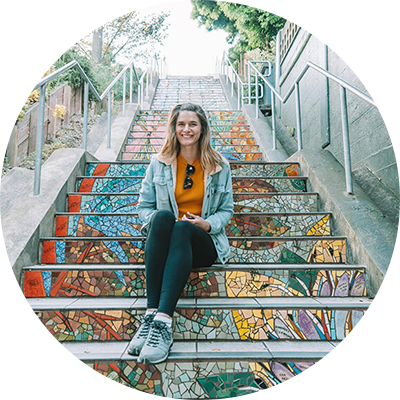Short on time? Our pick for the best barefoot hiking boots & shoes for max comfort is the Vivobarefoot Tracker II (Shop Women’s) (Shop Men’s).
The best barefoot hiking boots to promote healthy feet on the trails.
I’ve worn barefoot shoes for the last six years, and I have no intention of returning to traditional hiking shoes!
The phrase, “Barefoot hiking shoes” is the ultimate oxymoron, no?
The barefoot movement began with the book Born to Run, about a native tribe in Mexico that runs long distances wearing extremely minimal footwear without injury.
Today, the barefoot movement in the United States embraces hiking shoes with wide toe boxes, zero drops (no height difference between the heel and toe), and thin, flexible soles that help you feel the ground as you walk.
Why should anyone wear hiking shoes without ankle and arch support? The idea is that barefoot footwear may help you develop your natural foot and ankle musculature, which may, in turn, improve posture.
Plus, some people enjoy the groundedness that comes with feeling the ground beneath their feet.
I wear barefoot shoes because I have a foot issue that makes narrow shoes *impossible* for me.
Below I’ve rounded up the best barefoot hiking shoes in 2024. I’ve also created a buying guide to help you learn the difference between “barefoot” and “minimalist” hiking shoes and give you some tips about transitioning to barefoot shoes for hiking.
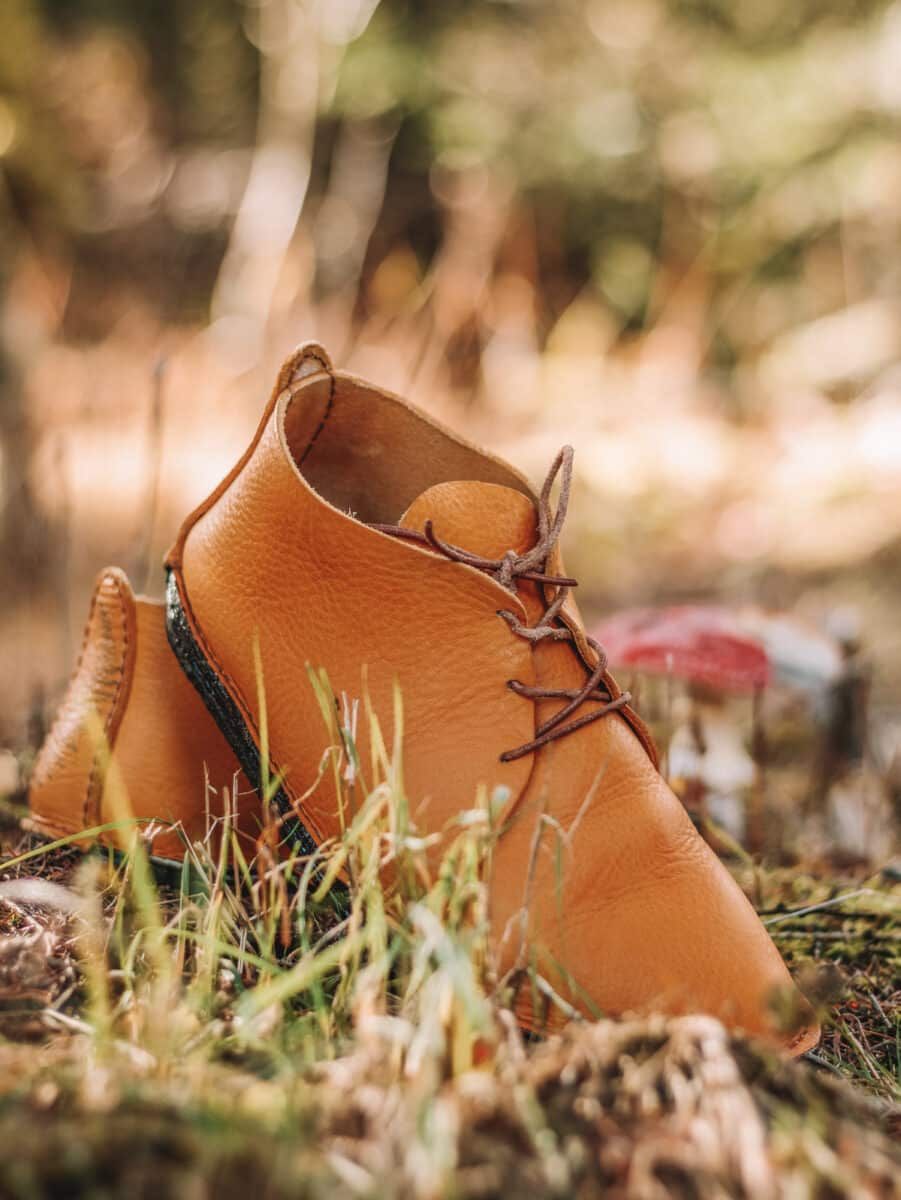
Here’s a quick look at our recommendations
- Altra Lone Peak 7 Trail-Running Shoes
- Xero Shoes Alpine Snow Boot
- Merrell Vapor Glove 6 Trail-Running Shoes
- Xero Shoes Mesa Trail Shoes
- Vivobarefoot Tracker II
- Be Lenka Barefoot Ranger 2.0
- Xero Shoes Xcursion Fusion
- Lems Trailhead
- Softstar Switchback
- Freet Mudee
- Joe Nimble Wander-Toes 2.0
- Lems Boulder Boot
- Freet Feldom
- Zaqq Expeq
- WHITIN Wide Minimalist Barefoot Sneakers
#1 Altra Lone Peak 7 Trail-Running Shoes
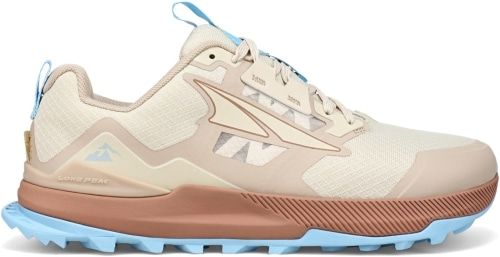
Our Rating: 5/5
Drop: Zero
Waterproof: No
Weight: 1 lb 2.4 oz
Stack: 25mm
The Altra Lone Peak 7 Trail-Running Shoes (Shop Women’s) (Shop Men’s) are some of the best barefoot hiking shoes.
These are the same shoes I’ve worn for years over hundreds of miles of trail. They’re suitable for light hiking and rough terrain, plus they’re great for running.
The Lone Peak 7 is Altra’s latest design of the classic Lone Peak. The Lone Peak 7 features a grippy sole plus a breathable mesh upper.
This barefoot shoe has moderate cushion, and the American Podiatric Medical Association gave Lone Peak its Seal of Acceptance for promoting foot health.
My main gripe about these barefoot hiking shoes is that they tend to get holes quickly (or maybe that’s just because they’re all I wear), and the color options, in my opinion, are unattractive.
PROS
- Quick-dry mesh uppers
- Durable, grippy outsoles
- Moderate cushion
- American Podiatric Medical Association Seal of Acceptance
- Rock plate for added protection
CONS
- Won’t last more than two years
- Color options are strange
SHOP WOMEN’S
SHOP MEN’S
#2 Xero Shoes Alpine Snow Boot
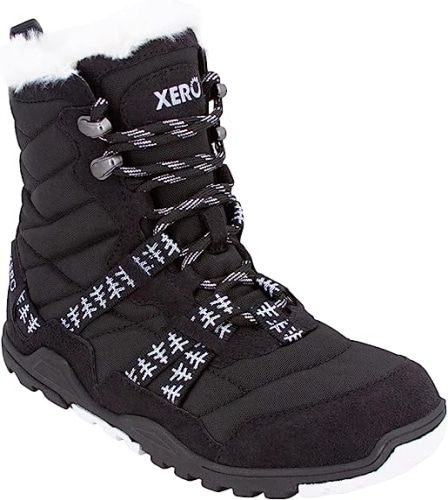
Our Rating: 4.7/5
Drop: Zero
Waterproof: Yes
Weight: 11.9 oz
Stack: 2mm
Finding lightweight winter boots is a challenge in the conventional shoe market, but thankfully Xero Shoes has a barefoot answer.
Xero Shoes is one of the top names in barefoot hiking shoes, and their Alpine Snow Boot (Shop Women’s) (Shop Men’s) is one of the best women’s barefoot hiking boots for winter.
These zero-drop hiking boots are warm and incredibly lightweight (under one pound), with a fleece lining and a removable heat-reflective insole.
The toe box is nice and wide, and the thin, 2mm “FeelTrue” sole allows you to feel the ground.
These barefoot boots are vegan-friendly, and Xero offers free domestic exchanges if you don’t like the boot’s fit.
PROS
- Removable thermal insole
- Very lightweight
- Highly insulated (rated to -25 degrees F)
- Vegan friendly
CONS
- Sizing runs small
- Quality issues
SHOP WOMEN’S
SHOP MEN’S
#3 Merrell Vapor Glove 6 Trail-Running Shoes
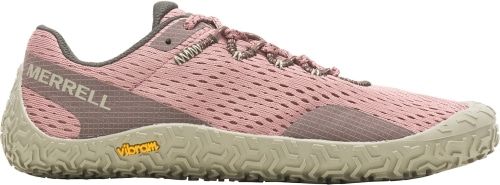
Our Rating: 4.8/5
Drop: Zero
Waterproof: No
Weight: 11.3 oz
Stack: 6mm
The Merrell Vapor Glove 6 Trail-Running Shoes (Shop Women’s) (Shop Men’s) are perfect for warm weather hiking and running.
I appreciate the high percentage of recycled materials in the Vapor Glove 6. The breathable mesh upper layer is 100% recycled (and keeps your feet from getting sweaty), plus it has a “bellows” tongue which keeps rocks and dirt out of your shoe.
Merrell uses Cleansport NXT treatment to give the Vapor Glove some odor control, and the durable Vibram rubber outsole provides excellent traction.
On the downside, these minimalist hiking shoes easily pick up rocks in the tread, and the ankle padding gets mixed reviews. Some people love and feel supported by it; others find it makes the shoe look puffy.
PROS
- Breathable mesh uppers
- Cleansport NXT odor control
- Bellows tongue helps keep rocks and dirt out of the shoe
- Durable Vibram Ecostep outsoles
- A high percentage of recycled materials
CONS
- Tread picks up rocks
- Ankle padding gets mixed reviews
SHOP WOMEN’S
SHOP MEN’S
#4 Xero Shoes Mesa Trail Shoes
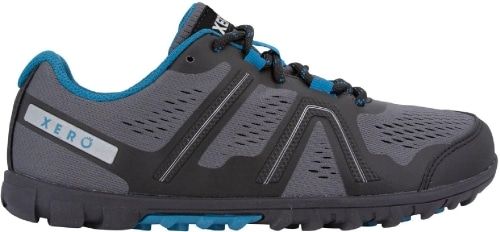
Our Rating: 4.8/5
Drop: Zero
Waterproof: No
Weight: 14 oz.
Stack: 12mm
Xero Shoes Mesa Trail Shoes (Shop Women’s) (Shop Men’s) offer another great option if you want a trail-running shoe for hiking.
My favorite feature of these Xero hiking shoes is that Xero guarantees the rubber outsole with its 5,000 Mile Sole warranty.
This warranty is good for two years, and if you wear down your FeelTrue outsoles to less than 1mm thick, they’ll give you a 60% off discount on a replacement pair of shoes.
In addition to this great warranty, these lightweight hiking shoes weigh under one pound and are vegan-friendly. You can take out the 3.5mm insole to customize how much ground feel you want, and, like all of the best minimalist hiking shoes, you’ll enjoy a wide-toe box.
The cons to these barefoot shoes are that they run about a half size small and the color choices are limited.
PROS
- Removable insole for a customized feel
- FeelTrue rubber outsoles have the Xero 5,000 Mile Sole warranty
- Vegan friendly
- Wide toe box
CONS
- Runs small (by ~ one-half size)
- Limited color choices
SHOP WOMEN’S
SHOP MEN’S
#5 Vivobarefoot Tracker II
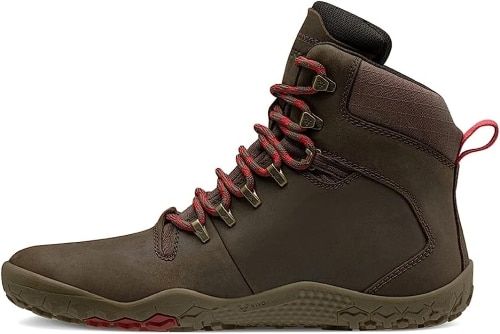
Our Rating: 5/5
Drop: Zero
Waterproof: Yes
Weight: 1.64 lbs
Stack: 5.5mm
Vivobarefoot shoes are another top brand for barefoot hiking shoes, and their Tracker II (Shop Women’s) (Shop Men’s) is one of the best men’s barefoot hiking boots because of their rugged aesthetic.
These Vivobarefoot hiking boots are a premium product. Vivobarefoot uses “wild hide” leather from free-ranging, small farm cattle for this all-leather shoe.
The Tracker II has grippy rubber soles with a thermal insole that regulates your temperature regardless of whether you run hot or cold.
If this sounds like an expensive feature, don’t worry, it is! Kindly, Vivobarefoot offers a 100-day trial run on all their barefoot boots so you’re not stuck with them if they don’t work.
Finally, if you buy this barefoot hiking boot, you get 50% off the VIVOHEALTH Barefoot Fundamentals Course, where you’ll learn tips on adopting a barefoot lifestyle.
PROS
- Waterproof boot
- 50% off the VIVOHEALTH Barefoot Fundamentals Course
- “Smart” thermal insole
- 100-day trial on all orders
- Sticky rubber outsole
CONS
- Expensive hiking boots
SHOP WOMEN’S
SHOP MEN’S
#6 Be Lenka Barefoot Ranger 2.0
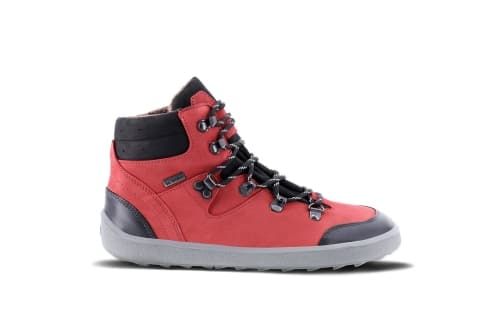
Our Rating: 4.5/5
Drop: Zero
Waterproof: Yes (water resistant)
Weight: Not listed
Stack: 4mm
I have a pair of Be Lenka barefoot shoes, and I love them! Be Lenka is a European company specializing in casual footwear, so the Ranger 2.0 (Shop Women’s) (Shop Men’s) are best suited for light hiking.
The Be Lenka Ranger 2.0 uses the DeepGrip and WinterGrip sole for maximum traction, plus it has rubber edging around the toe box and heel for durability. Be Lenka also put a fleece liner in the boot for warmth.
This stylish hiking boot comes in various fun colors, all in oiled nubuck to resist water stains.
Be prepared for an extended shipping time for these minimalist hiking shoes (at least mine took a long time), and if you’re unsure about which size to order, Be Lenka has a handy sizing guide for their hiking boots online.
PROS
- DeepGrip plus WinterGrip sole for traction
- Oiled nubuck resists water stains
- Fleece lining for warmth
- Rubber edging around the toe box for durability
- The sizing guide on Be Lenka website
CONS
- Best for light hiking
- Shipping can take a long time
#7 Xero Shoes Xcursion Fusion
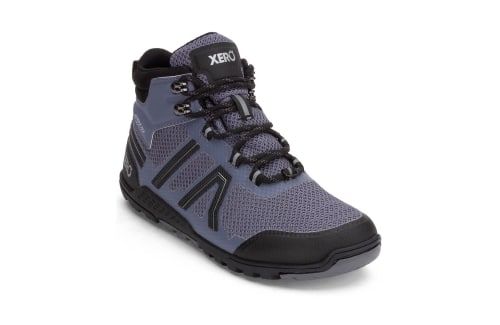
Our Rating: 5/5
Drop: Zero
Waterproof: Yes
Weight: 13.7 oz
Stack: 10mm
The Xero Shoes Xcursion Fusion (Shop Women’s) (Shop Men’s) are some of the best-rated minimalist hiking boots.
My favorite feature of these hiking shoes is the adjustable mid-foot straps. These straps straddle the middle of the foot and allow you to customize the shoe’s feel against your foot.
The Xcursions are some of the best minimalist hiking shoes because they’re also 100% waterproof. They have a seam-sealed inner bootie, an impermeable membrane on the inside of the shoe, plus a gusseted tongue to keep water out.
This barefoot hiking boot is made without any animal products, but, as Xero Shoes’ more rugged hiking boot, it has a rigid, durable sole that limits your ability to feel the ground.
The other consistent complaint about these shoes has to do with sizing, but everyone’s sizing complaint differed.
PROS
- Seam-sealed bootie with water-resistant membrane for 100% waterproof boot
- Gusseted tongue keeps water out
- Adjustable mid-foot and insole straps
- Vegan-friendly
CONS
- Limited ground feel
SHOP WOMEN’S
SHOP MEN’S
#8 Lems Trailhead
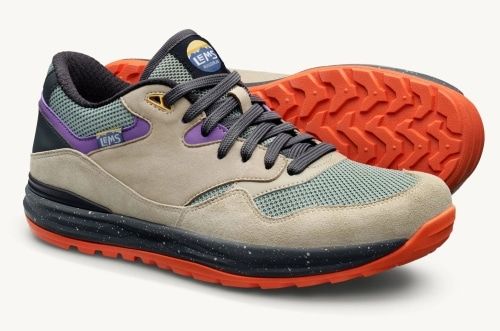
Our Rating: 4.6/5
Drop: 4mm
Waterproof: No
Weight: 9.5 oz
Stack: 17mm/21mm
The Lems Trailhead (Shop Women’s) (Shop Men’s) minimalist hiking shoes caught my eye because of the fun 90’s tennis shoe aesthetic, but I put them on this list because they’re a well-loved hiking sneaker.
This Lems barefoot hiking shoe is a cross between a tennis shoe and a boot. It’s got tennis shoe vibes but the durability of a more serious hiking boot.
The uppers on this minimalist hiking shoe have durable microfiber and mesh, which dries quickly and keeps your feet cool.
The Trailehead features a moderate cushion and, unlike other Lems hiking boots, has a “natural” toe box shape, meaning it’s narrower than other barefoot hiking shoes. People with wide feet may not like the Trailhead because of this feature.
The biggest drawback on this pair of Lems hiking boots is that they have some drop! They have 4mm of drop, but that’s still 8mm less than a traditional shoe.
PROS
- Fun 90’s aesthetic
- Upper made from durable microfiber and mesh
- Moderate cushion
- “Natural-shaped toe box” for a narrower fit
CONS
- 4mm of drop
- It fits narrower than other Lems styles
#9 Softstar Switchback
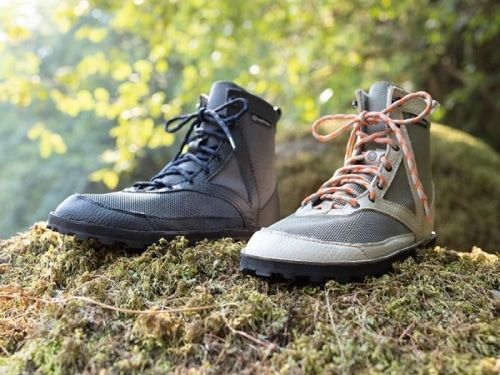
Our Rating: 5/5
Drop: Zero
Waterproof: Yes, water-resistant
Weight: Varies based on fabric choice
Stack: 9.5mm
I am very impressed by the Softstar Switchback barefoot hiking shoes (Shop Unisex).
These minimalist hiking shoes may look like traditional hiking boots, but you can choose between a Superfabric or all-leather upper.
The Softstar Superfabric lives up to its name. It’s water resistant, quick dry, breathable, flexible, lightweight, antibacterial, puncture resistant, easy to clean, and made in the USA.
The Switchback uses Vibram Megagrip soles for a durable hiking tread, and you can get the Switchback in wide sizes (even standard barefoot toe boxes are too narrow for me sometimes).
The Softstar “Elves” (as they call themselves” line this hiking boot with Merino wool, and you can purchase a replacement Merino insole when yours wears out.
For these reasons, I’d rate the Switchback as one of the best minimalist hiking boots for women.
PROS
- Vibram Megagrip soles
- Customizable uppers
- Wide sizing choices
- Lined with merino wool sourced from humanely-treated sheep
CONS
- Expensive
- Not fully waterproof
#10 Free Mudee
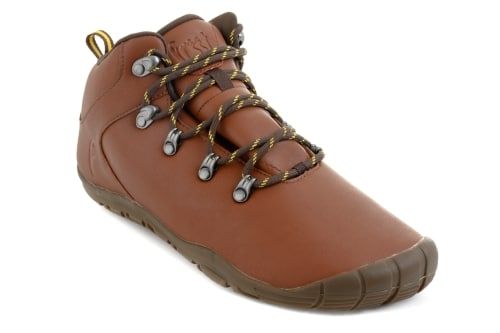
Our Rating: 4.7/5
Drop: Zero
Waterproof: Yes
Weight: Not listed
Stack: 7mm
If you’re looking for barefoot hiking shoes with a classic look, check out the Free Mudee hiking boots (Shop Unisex).
The newest version of the Mudee uses a new microfiber (MicroF2) upper that dries faster than the leather used in the older version. The fit is a little bigger than other Free models. However, they still run small, so plan for one size up from your usual.
Another feature I like about the Mudee is that you can opt for a rock plate. A rock plate is a durable shank in the sole that protects you from rocks.
These minimalist hiking boots are zero drops and are very warm and waterproof, with a more generous toe box than other barefoot brands.
PROS
- You can customize it with a rock plate
- Classic look
- Warm and very waterproof
- Plenty of toe room, even for wide feet
CONS
- Sizing runs small
- Weight not listed
#11 Joe Nimble Wander-Toes 2.0
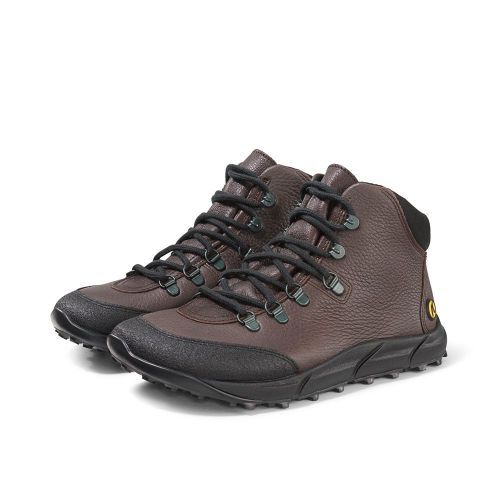
Our Rating: 4.9/5
Drop: Zero
Waterproof: No, water-resistant
Weight:1.4 lbs
Stack: 16mm
I like the Joe Nimble Wander Toes 2.0 (Shop Women’s) (Shop Men’s) because it has a classic leather hiking boot look with all-leather uppers.
Joe Nimble is a European company created by Lee Saxby, a biomechanist and world-renowned running coach.
Saxby puts science at the heart of all their shoes, and you can read about the science of good walking form on their website.
The Wandertoes uses Soles-by-Michelin (like the tires) for an extra secure grip and has a wide toe box for naturally splayed feet.
All-leather shoes don’t breathe well, but this barefoot hiking boot has a moisture-wicking liner to help absorb sweat.
You will pay a premium for these shoes, which only come in black and brown.
PROS
- Soles-by-Michelin for grip
- Moisture-wicking shoe liner
- Classic leather upper
CONS
- Expensive
- It only comes in black and brown
#12 Lems Boulder Boot
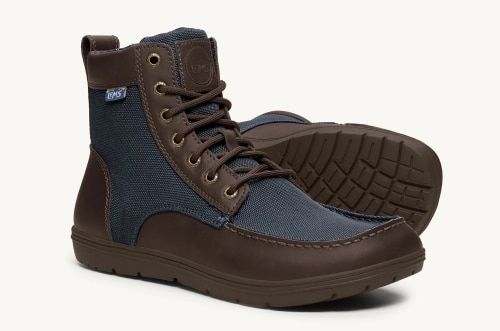
Our Rating: 4.7/5
Drop: Zero
Waterproof: No
Weight: 9oz
Stack:13.5mm
Lems Boulder Boots (Shop Women’s) (Shop Men’s) are a much-loved classic hiking boot.
This barefoot boot has a wide toe box for ample toe space and an over-the-ankle leather and nylon upper that’s stylish and functional.
Lems Boulder Boots are incredibly lightweight and flexible thanks to the injection blown rubber outsole. You can roll these shoes up and pack them anywhere.
I like that the Boulder Boots have lots of color and height options. You can choose an all-leather or leather and nylon mix and get the standard height or a mid-height.
I wish the Lems Boulder Boots did better in wet terrain. The traction on these hiking shoes needs improvement.
Another area for improvement with the Boulder Boots is that the stitching starts to fray after only a few months, making them look worn down.
PROS
- Lightweight and flexible
- Classic look
- Come in several colors and height options
CONS
- Needs better traction
- The sewing looks frayed after a short time
#13 Free Feldom
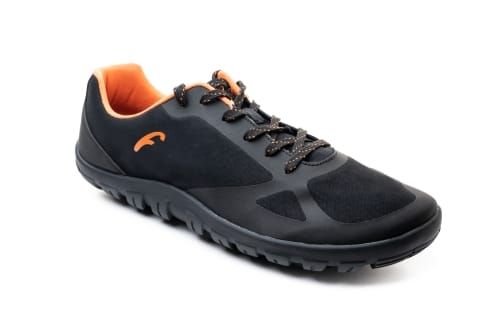
Our Rating: 4.8/5
Drop: Zero
Waterproof: No
Weight: Not listed
Stack: 10.5mm
The Freet Feldom (Shop Unisex) is a minimalist hiking and trail-running shoe made with recycled water bottles. The BottleYarn mesh is breathable and durable, and the Feldom is perfect for warm outings.
Freet’s minimalist hiking shoes are flexible, with a spacious toe box and zero drop. The Feldom barefoot shoe has a 10.5mm stack, allowing for a high level of ground feel, especially if you go without the removable 2.5mm insole.
I wish these minimalist hiking shoes came in more colors than just black.
That said, these barefoot hiking shoes have deep tread grips to keep you from slipping, and you don’t have to wear socks with them if you don’t want.
PROS
- Vegan-friendly and uppers made from recycled bottles
- Removable 2.5mm insole for a customized fit
- Deep tread grips
- It can be worn without socks
CONS
- It only comes in black
- Not waterproof
#14 Zaqq Expeq
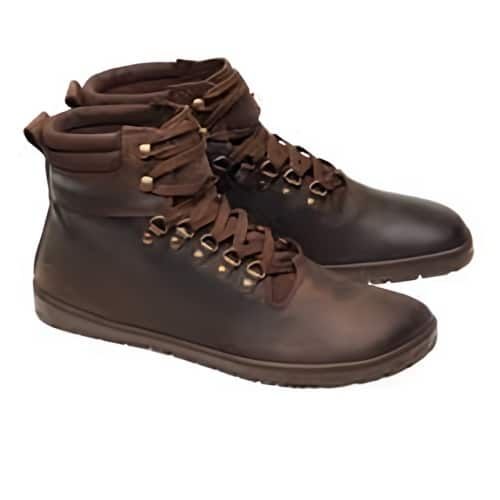
Our Rating: 4/7/5
Drop: Zero
Waterproof: Yes
Weight: 10.6 oz
Stack: Not listed
Zaqq Boots is a small business based in Germany whose mission is to create exceptional, high-quality minimalist hiking shoes.
The Expeq (Shop Unisex) is their classic, all-leather minimalist hiking boot.
This zero-drop hiking boot uses high-quality Nappa leather that, with the waterproof inner ZAQQ membrane, is 100% waterproof.
Zaqq makes the soles from a super flexible, non-slip rubber with 3.5mm lugs, and the hand-stitched shoes are still incredibly lightweight at well under one pound.
The product description for the Expeq says that it comes in men’s and women’s sizes, but I only see one sizing option–maybe there’s a translation issue? Some of the site is in German.
PROS
- Nappa leather is waterproof
- Classic hiking boot design
- Super lightweight
- Handstitched shoes
CONS
- Some of the website is in German, which may make ordering confusing
#15 WHITIN Wide Minimalist Barefoot Sneakers
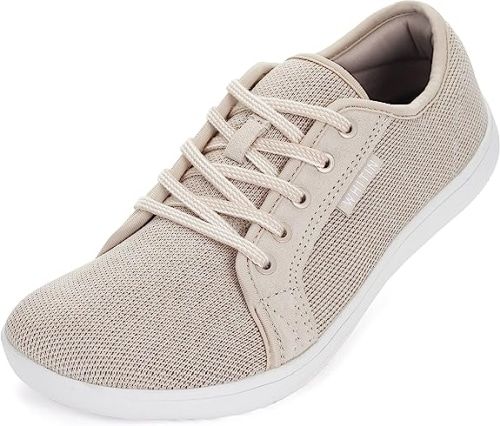
Our Rating: 4.5/5
Drop: Zero
Waterproof: No
Weight: 15.8 oz
Stack: Not listed
Many barefoot minimalist shoes are expensive. Whether that’s because they’re made in Europe or they’re custom-made here in the USA, it’s nice to try a new style without a significant cash investment.
The last barefoot shoe on my list is the WHITIN Wide Minimalist Barefoot Sneaker (Shop Women’s) (Shop Men’s). These are some of the best minimalist hiking shoes on a budget.
The WHITIN Barefoot sneaker has all the features of a standard minimalist hiking shoe: no drop, a wide toe box, and a thin, flexible sole.
These barefoot walking shoes come in various neutral colors and in men’s and women’s sizes.
The shoe’s upper is knitted, so while it isn’t waterproof and may lack durability, it will at least dry quickly.
PROS
- Budget-friendly
- Flexible sole
- Thin sole for ground feel
- Wide toe box
CONS
- Minimal tread
- Not waterproof
Buying Guide: How to Choose the Best Barefoot Hiking Shoes & Boots
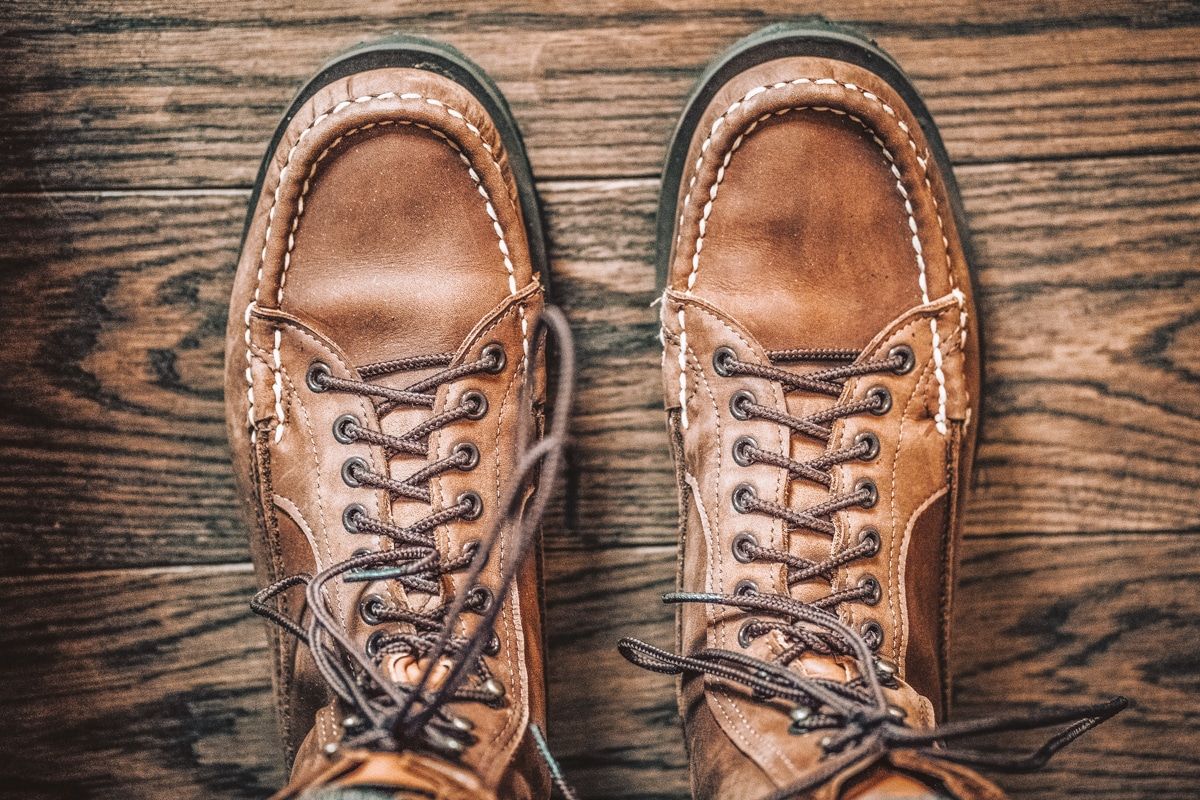
What to Look for in Barefoot Hiking Shoes
Barefoot vs. Minimalist
First, “barefoot shoes” and “minimalist shoes” are not synonymous. Both barefoot shoes and minimalist footwear have zero drop soles and a wide toe.
The difference is that minimalist hiking shoes will have thin, flexible soles to promote ground feel.
In contrast, barefoot shoes may not have the same sole you’d find on the best minimalist hiking shoes. Barefoot shoes have thicker soles and cushioning to protect your feet from rough terrain.
Zero Drop
All the top barefoot hiking boots have a zero drop sole, meaning there is no height difference between the heel and toe of the hiking boot. These are the opposite of high-heeled shoes, which may have a drop of several inches.
Yes, this means barefoot shoes are entirely devoid of arch support.
Anatomical Toe Box
My favorite feature of barefoot shoes is the wider toe box. Regardless of whether you have wide or narrow feet, most traditional hiking boots don’t accommodate the anatomical splay of your toes.
The wide-toe box can look clownish at first, but trust me; you’ll get over it when you notice how comfortable your feet are.
Stack
The stack of a shoe is the thickness of the outsole and insole combined, measured in millimeters (mm). For a zero-drop sole, the stack should just be one number.
If a shoe has a drop, they’ll list the stack with the toe height followed by the heel height (i.e., 17mm/21mm).
The thicker the stack, the less ground you feel.
Thin, Flexible Sole (Optional)
A hallmark of minimalist boots is flexible, thin soles. Feeling the ground through your shoes is a big plus in the barefoot movement.
However, it’s the feature I am least sold on, especially when it comes to hiking shoes.
It’s uncomfortable to feel all the rocks on the trail, and if the soles are too thin, you can break through them and scrape yourself. No thanks!
If you’re keen on embracing the minimalist shoe movement, condition your feet on short, relatively well-groomed trails before taking longer treks.
Ankle Protection (But Not Support)
A traditional hiking boot has stiff uppers for ankle support. On the other hand, barefoot hiking boots may have durable leather uppers, but the purpose is to protect your ankles from rocky trails rather than support your legs.
Waterproof
No one likes to hike with their feet wet. The best waterproof barefoot hiking boots will keep your feet dry and breathable. You can choose leather or synthetic hiking boots to accomplish this.
Lightweight
A final fundamental tenet of the barefoot hiking movement is that your shoes should be lightweight to mimic walking barefoot.
Types of Barefoot Hiking Shoes
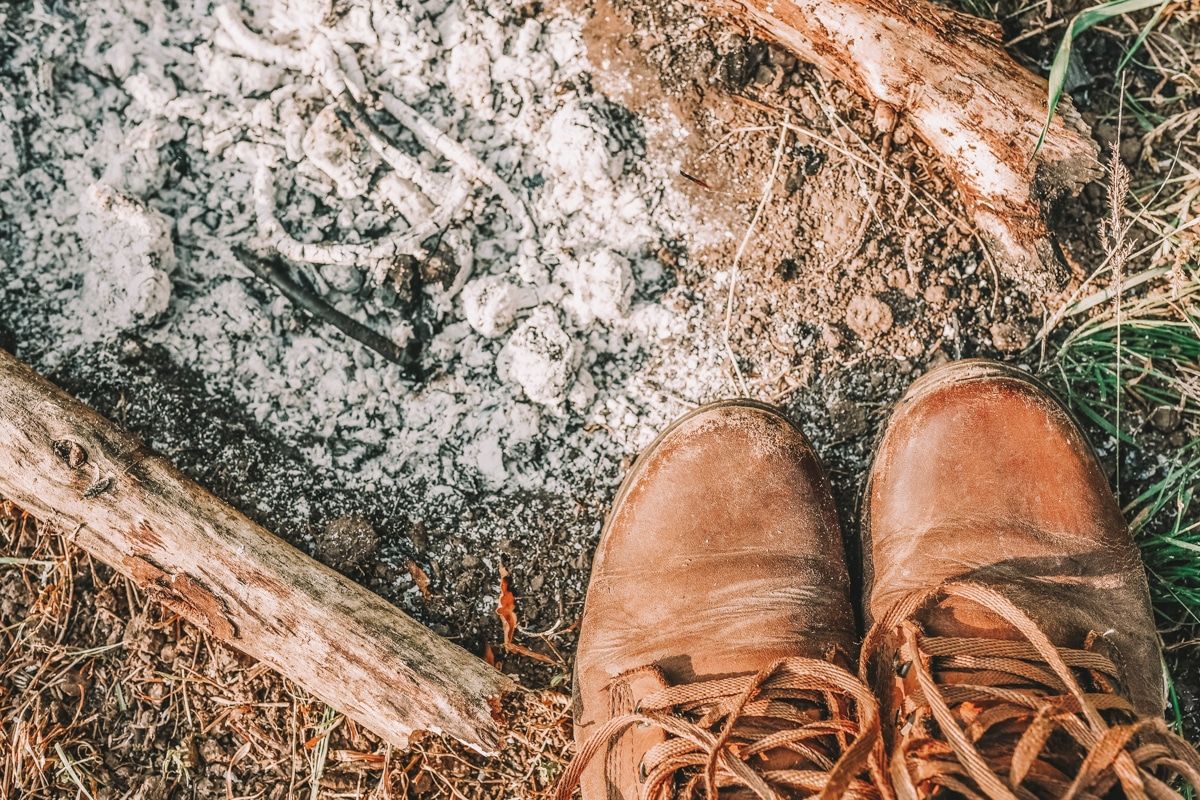
Sandals
I always hike in sandals, particularly in the hot summer months. This type of minimalist hiking shoes is great for short hikes or for people with troublesome toe issues (like me).
I like to have thick, durable soles on my hiking sandals, but the sole thickness is a matter of personal preference. I recommend a durable Vibram outsole or something similarly rugged.
Interested in minimalist hiking sandals? Check out our article on the best barefoot sandals for hiking!
Tennis Shoe Styles
Minimalist trail runners are another great barefoot hiking shoe. Unlike leather, which may not breathe well, you can get a mesh upper on these sneaker-style barefoot shoes, which breaths very well.
Note that some tennis shoe styles are “barefoot” because they’re zero drops with a wide toe box, but they don’t quite qualify as minimalist hiking shoes because they have thick, cushioned soles.
Low-Topped Boots
Many hiking boots are cut similarly to tennis shoes, with the top just under the ankle. This type of barefoot hiking boot is excellent for long summer hikes.
You’ll benefit from the protection of a sturdier shoe but avoid the potential discomfort of a high-top boot.
Ankle-High Boots
Above-the-ankle barefoot hiking boots are perfect for winter and fall hikes. When I got into hiking over ten years ago, the dudes at REI explained that high-top hiking boots were essential for ankle support.
Now I only opt for beefier hiking shoes when the weather is too cold for sneakers or sandals.
Tips for Hiking in Barefoot Boots
- Start Slow. It will take time to condition your feet for barefoot hiking. Plan for at least one month of conditioning before you take extended hikes in barefoot shoes.
- Barefoot shoes will feel uncomfortable and unsupportive compared to regular shoes. Don’t get too discouraged.
- Condition the bottom of your feet using a foot massage ball or walking barefoot in the yard. Since barefoot boots are thin, you’ll feel the ground more than in conventional shoes.
- Bring a spare pair of traditional shoes to switch out if you get too uncomfortable.
- Wear toe socks. If thicker socks compress your toes together, consider switching to toe socks.
- Purchase from brands that offer trial periods or a money-back guarantee. That way, if the shoes don’t work, you won’t be out any cash.
Check out this video for some excellent advice for transitioning to barefoot shoes.
FAQs About Barefoot Hiking Boots and Shoes
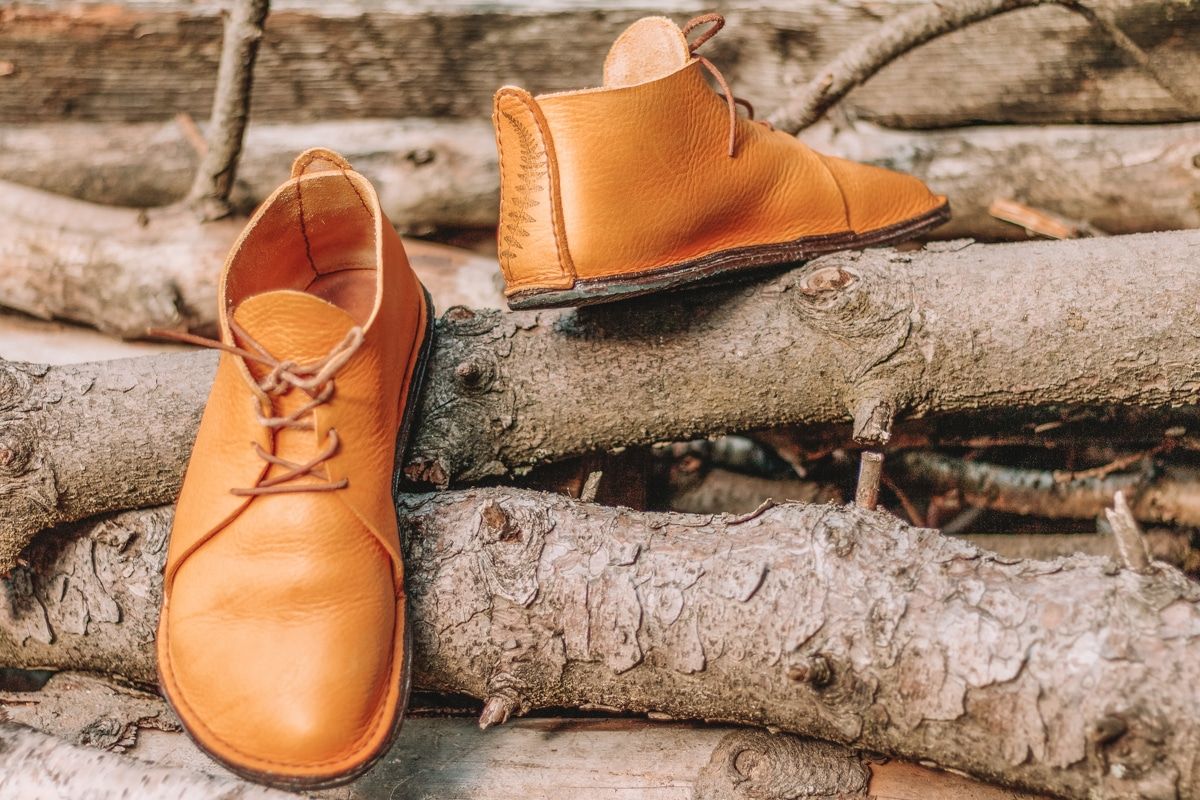
Are barefoot shoes good for hiking? Can you hike in barefoot shoes?
Barefoot shoes can be great for hiking, provided you have conditioned your feet over time to walk in barefoot shoes.
Here are some of the pros to hiking in barefoot shoes:
- No-drop hiking boots allow your Achilles tendon and calf muscles to stretch naturally.
- Increased foot and ankle musculature
- Wide toe box for ample toe space
- The best barefoot hiking shoes are lightweight, so you can easily pack more than one pair if you need to change them.
- Better ability to feel the ground. Some outdoor enthusiasts love to experience the trail by feeling every step carefully.
Here are some of the cons of barefoot hiking shoes:
- The thin sole may not adequately protect your feet from sharp objects
- It takes time to transition safely to barefoot shoes
What is the difference between regular hiking shoes and barefoot hiking shoes?
Traditional hiking shoes emphasize arch support with a stiff sole and a rigid, over-the-ankle height. These hiking shoes’ design keeps protection and support in mind.
Barefoot hiking shoes are designed with a different set of values in mind. Barefoot shoes provide enough protection to your feet while allowing you to move naturally and develop natural musculature, which, in turn, may help you achieve a straight, healthy posture.
Barefoot hiking shoes have a zero drop sole, meaning no height difference between the toe and heel.
Barefoot hiking shoes have an anatomical sole shape, meaning the toe box is wide, not narrow. Finally, this will be a flexible shoe and a lightweight shoe. The flexible, thin sole allows you to feel the ground as you move.
Is it better to hike barefoot? Does walking barefoot make you healthier?
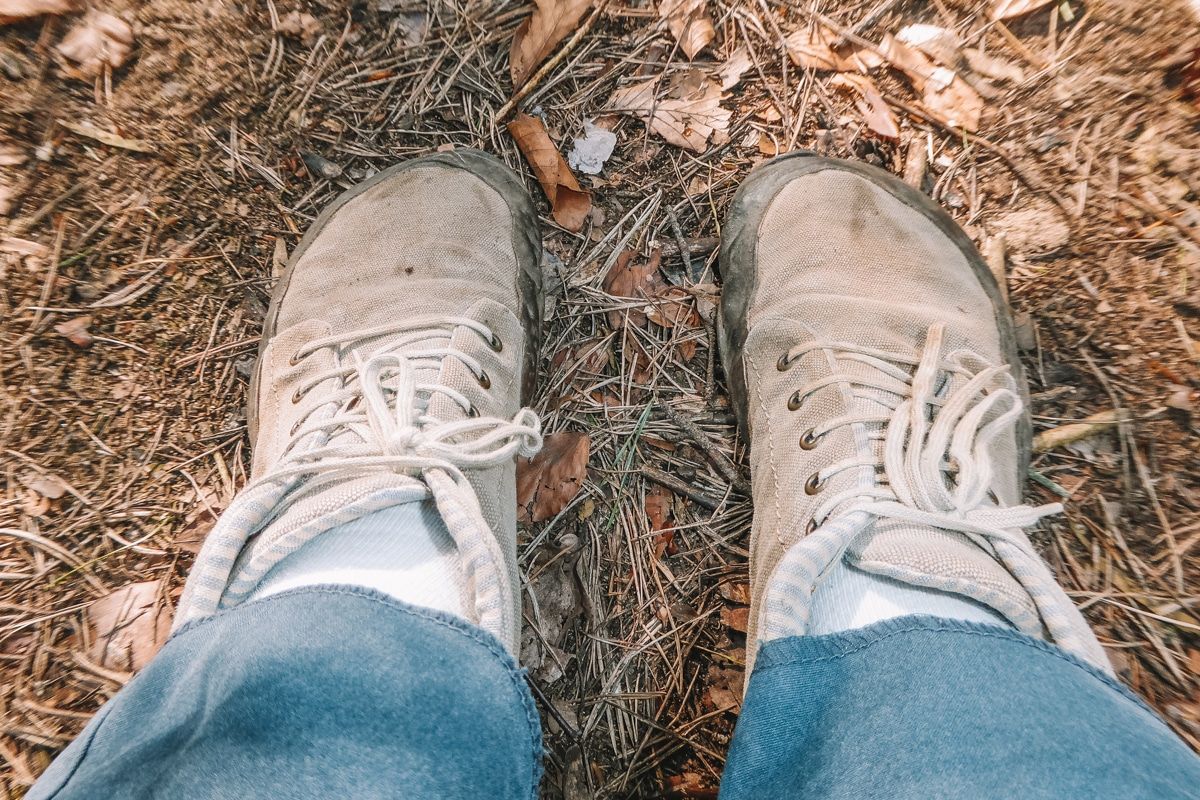
I do not recommend that anyone hike barefoot. Hiking without shoes puts you at a high risk of cutting, scraping, and bruising your feet. You are more susceptible to snake bites, insect bites, and fungal infections without shoes.
Walking in barefoot hiking shoes may benefit the musculature of your feet and ankles, but you should transition slowly from traditional hiking shoes to barefoot hikers.
Some people enjoy experiencing the ground through their feet, and find it makes hiking more enjoyable. However, it bears mentioning that others find this experience painful or uncomfortable.
Is Vivobarefoot good for hiking?
Vivobarefoot is one of the top barefoot shoe brands. Other leading brands for barefoot hiking boots include:
- Altra
- Xero Shoes
- Zaqq
- Lems
Each foot is different, and there is no one shoe or one brand that works for everyone.
Thankfully, many barefoot brands offer trial periods to try the shoes out at home before you commit long-term.
What are the cons of barefoot hiking boots?
One of the cons of barefoot hiking boots is that you must build up your tolerance for them over time.
Since you will use different muscles while wearing barefoot hiking shoes than you will with conventional hiking shoes, you should give yourself time to build those muscles.
The best minimalist hiking shoes usually have thinner soles than what you’ll find on most hiking boots.
Without this thick sole, you may find it uncomfortable to walk in barefoot hikers because you’re not used to feeling the rocks under your feet.
Are barefoot hiking shoes worth it? Why not just hike barefoot?
Barefoot hiking shoes might be worth it if your feet hurt in traditional hiking shoes or if you’re interested in feeling the ground as you hike.
I was having pain while walking, and the switch to barefoot shoes saved my feet and allowed me to keep hiking outdoors–which I love.
There is a big difference between wearing barefoot shoes and walking completely barefoot. I do not recommend hiking barefoot (i.e., without shoes).
Hiking barefoot is a fast way to hurt yourself, as shoes protect you from rocks, sharp sticks, snakes, bugs, poop, and other undesirable things on the ground.
Conclusion: Our Pick for the Best Barefoot Hiking Boots
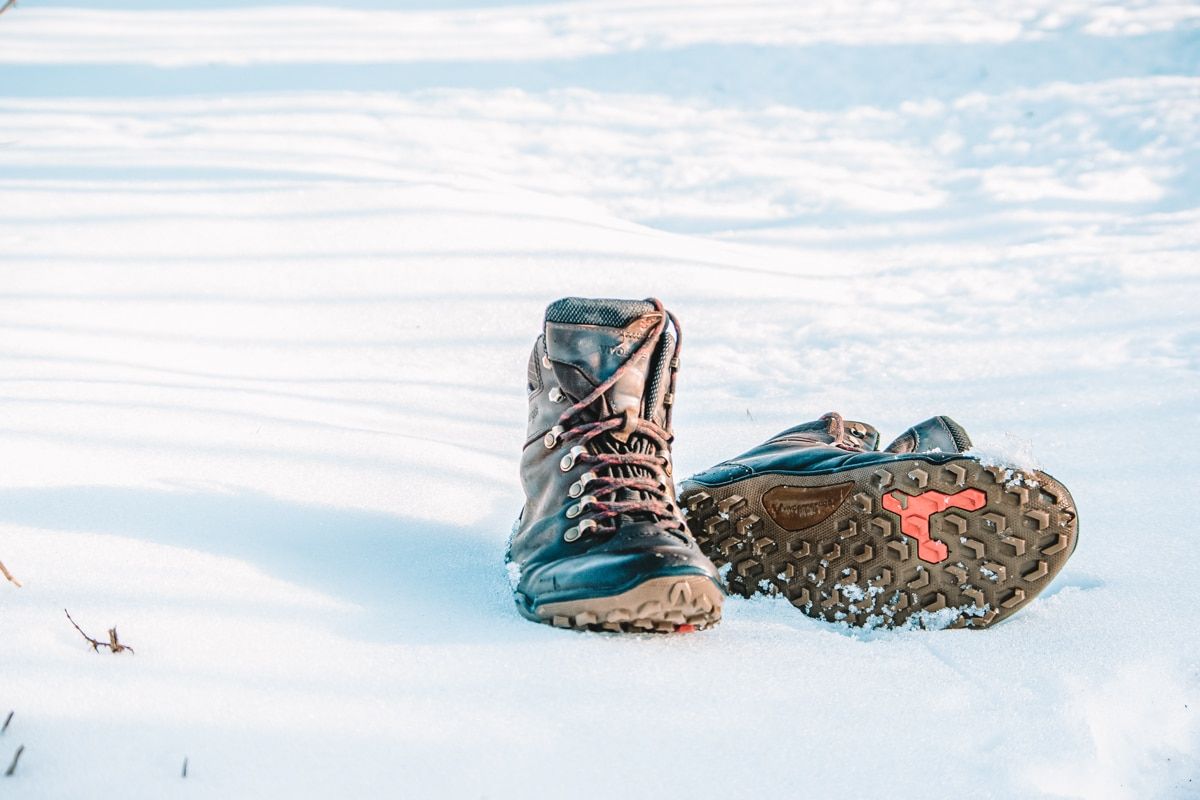
Finding an excellent barefoot shoe can be the beginning of a beautiful, active life.
For me, switching to shoes that supported my foot’s natural anatomy gave me freedom from walking pain, so I’m very grateful for the explosion of barefoot footwear in the US market.
There is no single best pair of barefoot shoes for everyone. You’ll almost certainly have some trial and error in your barefoot journey.
My pick for the best minimalist hiking shoes is the Vivobarefoot Tracker II (Shop Women’s) (Shop Men’s).
These zero-drop, waterproof boots have a classic, rugged aesthetic. Vivobarefoot uses “wild hide” leather from free-ranging cattle and a grippy rubber sole.
The smart thermal insole helps to regulate your temperature, and if you don’t like them, you have a 100-day trial run.
ABOUT THE AUTHOR

Meredith Dennis
Meredith is a biologist and writer based in California’s Sierra Nevada. She has lived in 6 states as a biologist, so her intel on hiking and camping is chef’s kiss next level. One of her earliest camping memories was being too scared to find a bathroom at night on a family camping trip. Thankfully, she’s come a long way since then and she can help you get there too!
On the hunt for the best footwear? Check out these related articles below!
Best Hiking Underwear for Women
Allbirds Wool Runners vs Tree Runners
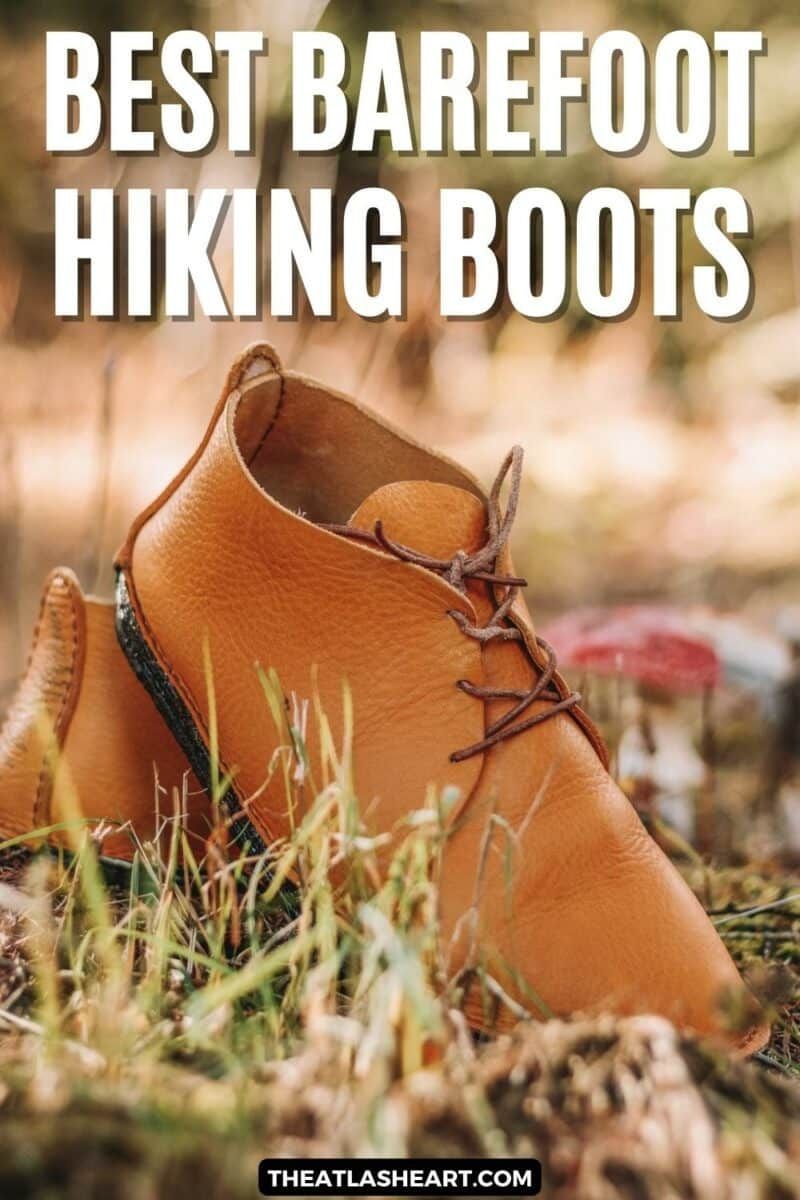
Pin this image for future reference

